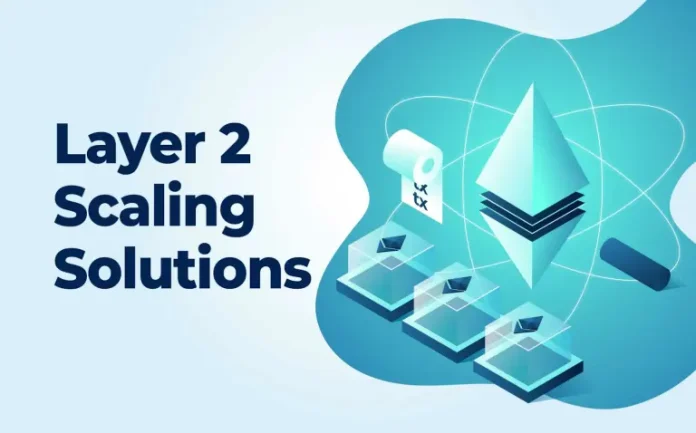Introduction
In the ever-evolving landscape of blockchain technology, scalability remains a paramount concern. As the popularity of decentralised applications (DApps) and blockchain platforms like Ethereum continues to surge, the need for efficient and scalable solutions becomes more pressing than ever. This is where Layer-2 scaling solutions come into play, offering a promising avenue to address the scalability challenges while preserving the security of the underlying main chain.
Understanding the Basics
Layer-2 scaling solutions aim to enhance the transaction throughput and efficiency of a blockchain network by processing transactions off-chain or in a secondary layer. Unlike sidechains, which may rely on external networks or validators, Layer 2 solutions directly inherit their security from the main chain. This unique characteristic ensures that the security model of the underlying blockchain is not compromised while achieving scalability.
Main Types of Layer-2 Scaling Solutions
Two prominent types of Layer-2 scaling solutions have gained traction in the blockchain space: zero-knowledge rollups and optimistic rollups.
Zero-Knowledge Rollups
Zero-knowledge rollups, often abbreviated as zk-rollups, leverage a cryptographic technique known as zero-knowledge proofs. These proofs enable the validation of transactions without revealing specific transaction details. In a zero-knowledge rollup, transaction data is compressed into succinct proofs, which are then submitted to the main chain for verification. This approach significantly reduces the amount of data processed on the main chain, leading to improved scalability.
Optimistic Rollups
Optimistic rollups, on the other hand, take a more optimistic approach to transaction validation. In this model, transactions are initially processed off-chain and subsequently submitted to the main chain for validation. The main chain assumes the validity of these transactions unless proven otherwise. This optimistic approach reduces the need for on-chain processing, enhancing scalability. However, a dispute resolution mechanism is in place to address any discrepancies that may arise.
Key Players in Layer-2 Scalability
Several Layer-2 scalability engines and solutions have emerged as frontrunners in the quest for scalable blockchain networks. Three noteworthy players in this space are Starkware, Optimism, and Arbitrum.
Starkware
Starkware has made significant strides in the development of Layer-2 scaling solutions, particularly in the realm of zero-knowledge rollups. The StarkWare protocol enables users to conduct transactions off-chain while providing cryptographic proofs for verification on the main chain. This approach not only enhances scalability but also ensures the security and integrity of the underlying blockchain.
Optimism
Optimism, formerly known as Optimistic Ethereum, is a Layer-2 scaling solution that employs optimistic rollups. By processing transactions off-chain and assuming their validity, Optimism reduces the burden on the main Ethereum chain. This results in faster transaction processing and lower fees, making decentralised applications more accessible and user-friendly.
Arbitrum
Arbitrum, developed by Offchain Labs, is another player in the optimistic rollup space. It aims to address Ethereum’s scalability challenges by facilitating faster and more cost-effective transactions. Arbitrum achieves this by processing most transactions off-chain and relying on the Ethereum main chain for dispute resolution. This hybrid approach strikes a balance between scalability and security.
Benefits of Layer-2 Scaling Solutions
The adoption of Layer-2 scaling solutions brings forth a plethora of benefits for blockchain networks and their users:
Scalability: The primary advantage of Layer-2 solutions is the significant improvement in scalability. By offloading a substantial portion of transaction processing to secondary layers, blockchain networks can accommodate a growing number of users and applications.
Reduced Transaction Fees: With increased scalability comes a reduction in transaction fees. Layer-2 solutions alleviate the congestion on the main chain, leading to lower fees and making blockchain interactions more cost-effective for users.
Improved User Experience: Faster transaction processing and lower fees contribute to an enhanced user experience. DApps and platforms running on Layer-2 solutions become more responsive and user-friendly, encouraging wider adoption.
Preservation of Security: Unlike some other scaling solutions, Layer-2 solutions prioritise the preservation of security by inheriting it directly from the main chain. This ensures that the robust security model of the underlying blockchain is not compromised in the pursuit of scalability.
Challenges and Considerations
While Layer-2 scaling solutions offer promising advancements, it’s essential to acknowledge the challenges and considerations associated with their implementation:
Adoption and Interoperability:
The success of Layer-2 solutions relies on widespread adoption. For these solutions to be effective, developers, users, and existing platforms must seamlessly integrate with and transition to these new scaling mechanisms. Additionally, interoperability between different Layer-2 solutions is crucial for a cohesive and interconnected blockchain ecosystem.
Security Concerns:
While Layer-2 solutions inherit security from the main chain, it’s crucial to scrutinise the specific security mechanisms employed by each solution. The implementation of cryptographic techniques and the robustness of dispute resolution mechanisms play a vital role in ensuring the overall security of the network.
Education and Awareness:
The blockchain community must actively engage in educating users and developers about the benefits and risks associated with Layer-2 scaling solutions. Increased awareness can drive adoption and foster a deeper understanding of the intricacies involved.
Conclusion
Layer-2 scaling solutions represent a pivotal advancement in the quest for scalable and efficient blockchain networks. By striking a balance between scalability and security, solutions like Starkware, Optimism, and Arbitrum are shaping the future of decentralised applications and blockchain platforms. As the blockchain ecosystem continues to evolve, the adoption of Layer-2 scaling solutions is poised to play a pivotal role in unlocking the full potential of decentralised technologies. Developers, users, and stakeholders alike are encouraged to explore and embrace these innovative solutions to usher in a new era of scalable and secure blockchain interactions.
- Vodafone Idea’s Upcoming Fundraising: Aiming to Collect ₹18,000-20,000 Crore - April 11, 2024
- Is the Indian Stock Market Open Today? - April 11, 2024
- Emerging Regional Carriers Aim to Capture Growing Short-Haul Flight Market in India - March 25, 2024



